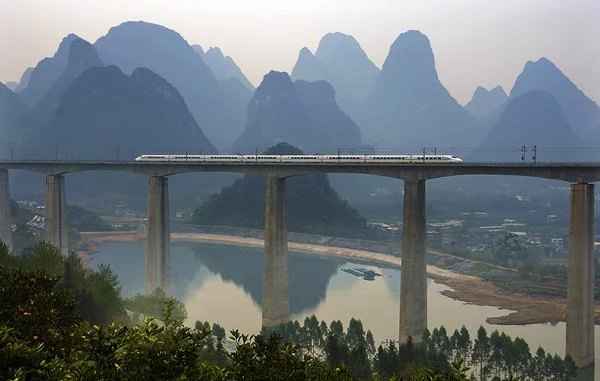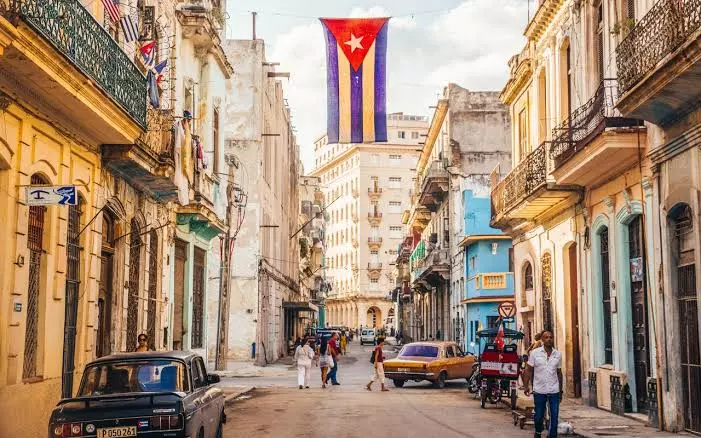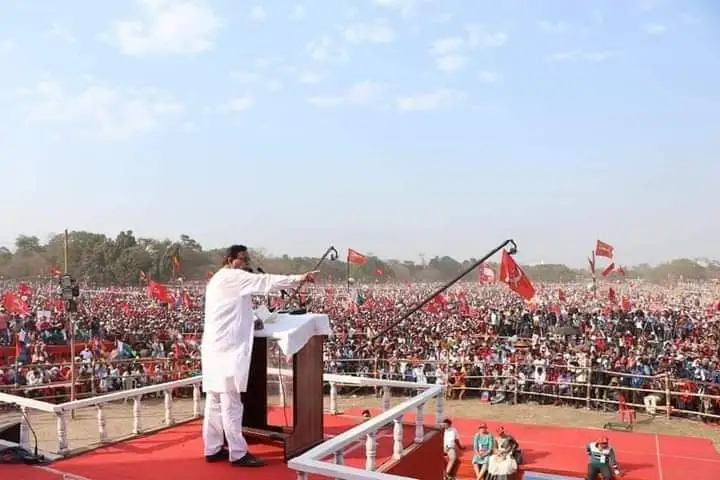The Soviet Union was born on the railroad. The October Revolution triggered not just a civil war but an invasion by the armies of fourteen foreign powers; utterly outnumbered, the Red Army won through superior organization and speed that only the railways could provide. From Moscow and Petrograd they radiated outward, liberating every city they could reach with their armored trains. Though the fortunes of the Bolsheviks varied dramatically over the years of the civil war, if a city was connected to either urban center by rail, once it turned red it would remain red.
In the years that followed, the Soviet Union built one of the greatest systems of railways the world has ever seen. It’s an often repeated statistic that in 1917 the Russian Empire had a less industrialized society than France in 1789; to advance from this point to construct nearly 150,000 kilometers of railroads in a few short decades is unparalleled. When the Blitzkrieg finally reached Stalingrad in 1942, Adolf Hitler complained that “we are discovering railway lines that are not on the maps.”[1 ]

Today, the railways of the former Soviet republics are sadly diminished; Russian Railways, their primary heir, maintains an operational length of only 85,000 kilometers. They are a casualty of the same wasting disease that has eroded railways and mass transit worldwide for the last half-century: neoliberalism.
Ferrocarriles Argentinos, the state-owned railway corporation of Argentina, once oversaw a network of 47,000 kilometers, making it not only the largest national railway in the Latin America but the sixth-largest in the world.[2] Neglected by successive administrations, the railways diminished and were eventually privatized in the 1990s at the insistence of the International Monetary Fund. Railway employment, once in the hundreds of thousands and controlled by a powerful union, was reduced by over 80%. Inter-city passenger service was reduced by 70%.[3] Today, only about 15,000 kilometers are used to transport freight in Argentina,[4] and 10,000 kilometers of rail have been dismantled entirely. In Mexico, a country of over 120 million people, rail privatization in 1995 marked the end of all passenger rail service, which so far has not returned.

Despite the incredible advances that rail technology has seen in recent years, much of the world’s railways remain obsolete and underutilized. The United States is the worst offender in this category; though it currently maintains the largest national rail network, less than 1% of it is electric. Trains powered by diesel fuel are only 30% as energy efficient as electric trains, as well as louder, more dangerous, and more directly tied to air pollution. This is in part another consequence of privatization: US freight transport corporations use diesel locomotives due to lower up-front costs, disregard for the externality of emissions, and the prioritization of short-term profits over long-term investments in modernization.[5]
In our era of climate change, it should be obvious that the airplane and the automobile are not the best future of transportation. The United States, which has less than 5% of the global population, currently emits 14% of the world’s greenhouse gases,[6] and of this, nearly one third is produced by the operation of motor vehicles, the single largest category of emissions.[7] Apart from a handful of very small countries[San Marino, Monaco, Iceland, and New Zealand, which combined have a total population of less than 5 million], the US has the most motor vehicles per capita in the world at an astounding 816 vehicles per 1000, over twice as many as nearly every other country.[8] Recent data also suggests that producing a new car creates as much emissions as driving it.[9] If the other 95% of the world were to drive as much as the US, the current total global rate of emissions would double—at least.
Nevertheless, the short-sightedness of private capital has ensured that this is the road upon which we will travel. Passenger rail service, the only possible alternative for the developing world, cannot be constructed in any significant quantity without heavy state intervention. The slow but steady expansion of Europe’s high-speed passenger rail network has been exclusively constructed by state-owned and subsidized entities. Japan is sometimes cited as a success story of privatized high-speed rail—yet the vast majority of its network was already constructed before the state-owned Japanese National Railways was privatized in 1987,[10] and new rail construction ever since has invariably still been paid for by the government and then leased to the heavily-subsidized private sector. Taiwan’s single high-speed line, initially touted as the largest such project to be wholly financed by a private company, took nearly a decade to construct and fell into such financial difficulty that the government took majority control only two years after it began service.[11]
The capitalist world’s futile struggles to profit off of rail transport confirm through empirical, statistical evidence what economic theory has long held: trains aren’t for making money. That is to say, rail transport must function as a public good if it is to ever be viable.

High-speed rail, the only possible large-scale alternative to burning billions of gallons of jet fuel every year, is extraordinarily expensive. Even the process of upgrading existing rail corridors to modern speeds nearly always entails the construction of brand-new railroads, as a straight line and a low elevation gradient are required for a train to maintain speeds of 200 or 300 kilometers an hour. This results in costly excavations of hillsides to bore tunnels, the construction of massive bridges to span rivers and canyons, and the placement of elevated columns across countrysides to sustain a level track. The new Boten–Vientiane railway, which opened in December of 2021 and stretches hundreds of kilometers across the mountainous terrain of Laos, is nearly two-thirds tunnels and bridges by length.[12] To suggest that the construction, maintenance, and operation of such a colossal piece of infrastructure could be paid for through ticket sales and still deliver a profit is absurd. Such a business model would at best result in a train that was accessible solely by passengers who were ultra-rich.

To make a world of rail a reality, we must instead return to the path blazed by the Soviet Union, and make use of its tools: central planning and public spending.
In sharp contrast to the United States’ concrete nightmare, and putting Europe and Japan to shame, over the last fifteen years the People’s Republic of China has chosen to spend on railroads, and spend big. Its high-speed rail network, begun from scratch in 2007, is now over 40,000 kilometers long—not just the largest in the world, but larger than the total length of all other high-speed lines in the world put together, and enough to wrap around the entire circumference of the Earth had it been placed in a single straight track. Over the past four decades, forty new metro rail systems have been built in the PRC with a total length of over 7,000 kilometers.[13] China’s railways serve over three billion passenger trips annually[14], and this only scratches the surface of their ambitions.

Through the Belt and Road Initiative, the Chinese government is working to build badly-needed rail infrastructure throughout the global south—infrastructure that the world cannot do without, if those countries are to develop along a sustainable path. In the past year alone, in addition to multiple new high-speed lines within China, Chinese state-owned enterprises completed new inter-city railways in Laos and Nigeria, and Vietnam’s first urban metro system in Hanoi. Currently, high-speed railways are also under construction in Indonesia and Thailand, with even more still in planning stages.

Managing the steep costs associated with these projects and maintaining the pace at which they are completed is only possible with a high level of economic planning. Year after year, western economists and “experts” (such as the libertarian Cato Institute) bemoan the massive debts incurred by Chinese state-owned railway companies (which are owed to Chinese state-owned banks, making the “problem” somewhat irrelevant), and the inability of its passenger lines to generate profit or even break even. And year after year, more railways are built and put into operation without uproar in defiance of this hidebound capitalist logic. Because, when taking into account the greater picture—not just the company’s bottom line and quarterly earnings but the total environmental and economic impact, high-speed rail is not just profitable but quite comfortably so, to the tune of a 6.5% return on investment. According to a study by a Chicago-based think tank, upon calculation of the difference in total operation costs when high-speed rail trips were substituted for airplane trips, plus the total time savings multiplied by the riders’ average hourly wage, China’s high-speed rail yielded a $2.4 trillion total benefit to a $2 trillion total expense.[15]

To overcome decades of neoliberal indoctrination and bring mainstream thought around to this paradigm—that public infrastructure costs money rather than loses money, and that that cost is spent to benefit the people, not the owners of private capital—is no easy task, and when confronted with the systemic hostility to these ideas that the capitalists have purchased, it may seem as mammoth a task as building a transcontinental railroad, or winning a civil war. But it needs to happen, for all our sakes. There is no alternative.






